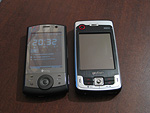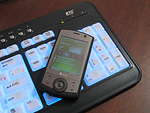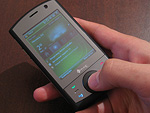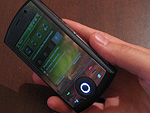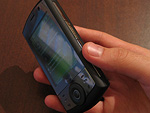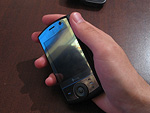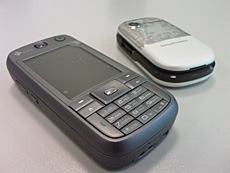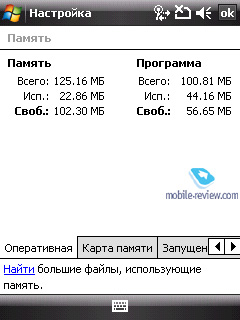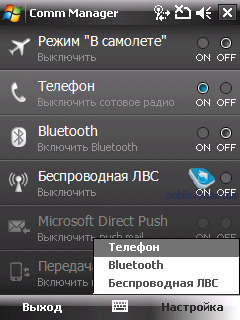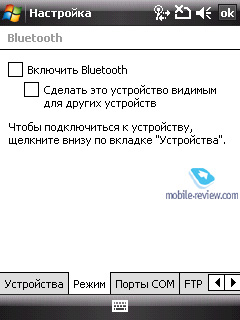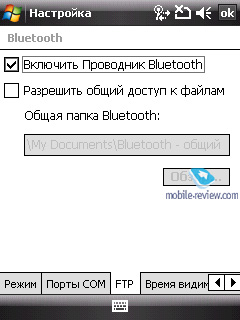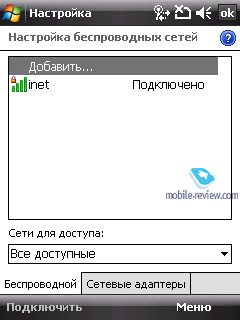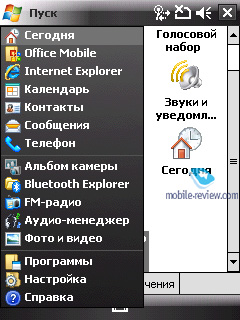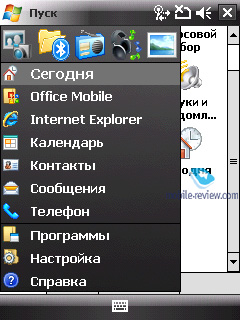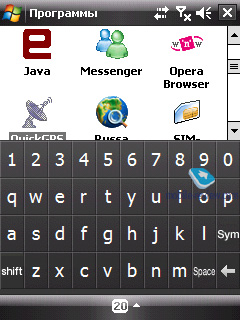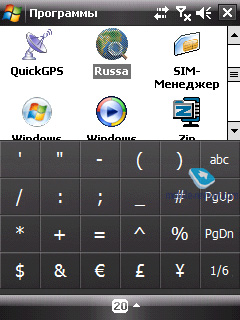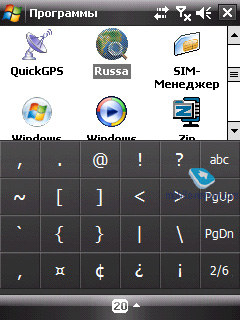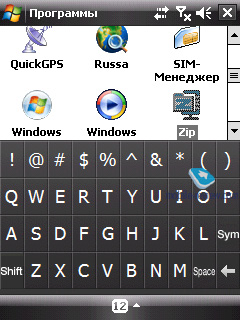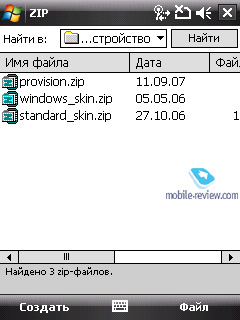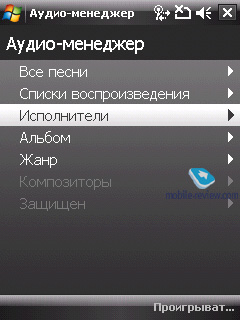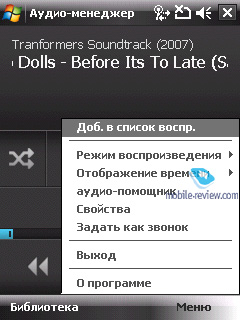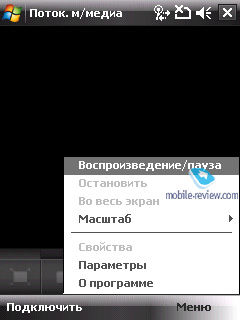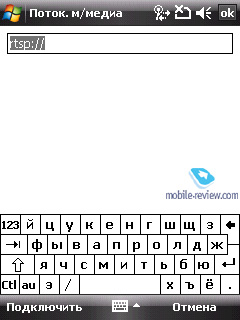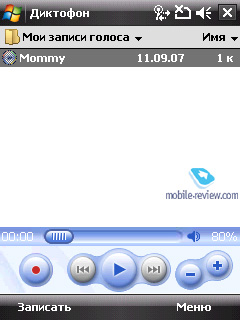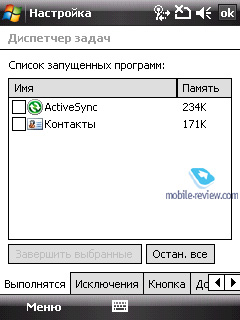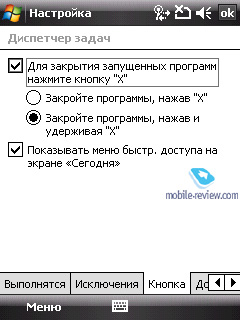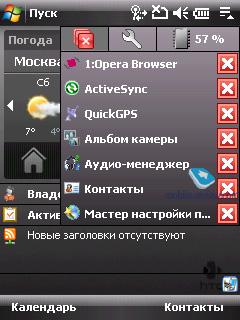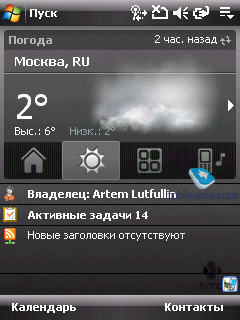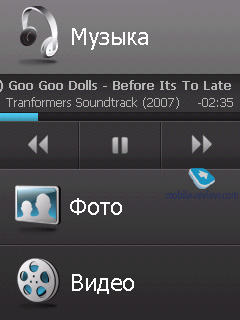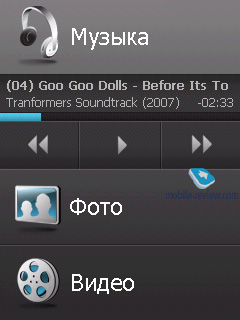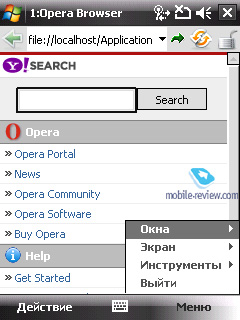|
|
Preview of UMTS-communicator HTC Touch Cruise
Live photos of HTC Touch Cruise
Table of contents:
- Preface
- Positioning
- Design
- Size, controls layout
- Controls
- Display
- Camera
- Battery life
- Performance
- Connectivity
- Software
- GPS
- Sales package, sound
- Impressions
Preface
The “rumor-it-fake-it” game is likely to become HTC’s trump very soon. For this, they have already taken some measures to cut off most leaks from inside the company. Another thing – indexes, and its pretty much tangled indexing system, whose consequences we witnessed with the HTC TyTN II, that got renamed a couple of times, dumping its numeric index and codename in favor of what it is today. Another example in this sense is the recently debuted HTC Touch Dual, that changed its name to the HTC Touch Slide a few days prior to the announcement (naturally, that’s the way it looked for consumers and the vast majority of journalists).
The announcement date of the HTC Polaris got postponed, and even though some info and images of this model were circulating around the Internet, rumor has it the design was bound to shape change before it hits the shelves. And let us be honest, after meeting the Polaris in person, we had pretty much similar feelings – it is design is a good example of what is called a “mixed bag”. But first things first.
One little thing of note. We had our mitts on a test sample, that’s why some data and results were omitted from this review, and some were impossible to prove due to a number of reasons. Check back when the communicator arrives on the market for our full series of tests.

Back to the table of contents >>>
Positioning
In many ways, the new device is positioned as a successor to one of the most sought-after communicators in the history of Windows Mobile – the HTC P3300 (Artemis).
Let’s start with the name. The HTC Polaris, which was its codename for a while, has a traditional numeric index as well – the P3650. The name it has assumed for the release day, the HTC Touch Cruise, has a couple of explanations to it. The first and the foremost – the company wants to speed up the development of the Touch series. On the tide of the HTC Touch success, they roll out a slider-type model in this range, and then come up with a navigation-savvy communicator.
This way, the target audience for the HTC Touch Cruise gets wider thanks to all users who have little idea of the brand itself, but have already played around or witnessed the HTC Touch in stores or borrowed it from friends. For these consumers, the brand isn’t of prime importance; the only thing that matters is that one of HTC’s models has literally got to them. And they can probably recall the name as well - the Touch. So that’s the thing the company aims to take advantage of. Mind the fact that the new communicator has nothing but a single word added to the original title – the HTC Touch. This “Cruise” suffix is very fitting as far as a navigation-savvy communicator is concerned.
Another reason for this name is more apparent – actually, they realized how important these names were a few months after the debut of the HTC P3300. Back then, over at HTC nobody really cared about codenames, that’s why it came as no surprise that the company’s hottest offering bore a very “recognizable” name – the P3300. Nevertheless, this communicator has always been known as the Artemis, although sold under its numeric index.
The timing in the case of the Cruise is also quite remarkable, for it came out roughly at the same time as the HTC P3300 a year ago. Interestingly, the HTC P3300 itself is still enjoying tidy sales and is not being withdrawn from the market. Perhaps it will be down the road, when the company will have its complete focus on the brand-new solutions. It has been a year since the P3300’s arrival and given that even for 2006 it wasn’t the most cutting-edge device around, a life cycle this long is quite something. In other words, right before the Christmas sales, the P3300’s time is about to run out, and that’s the moment when HTC will launch its successor.
The users of the P3300 might well find the newcomer of some interest thanks to a substantial design revamp, refined software and hardware departments. On top of that, the Cruise is very likely to top their short-lists, since the original communicator, the P3300, is getting hopelessly dated these days.
And now, be prepared, for we are taking a plunge to see what the HTC Touch Cruise has in stock for us.

Back to the table of contents >>>
Design
Like we said, the communicator’s looks is a mixed bag. While it may appear a no-nonsense, yet quite contemporary model, on the other hand it lacks some flavour – probably due to its dull but conventional, black with dark grey color scheme. On a side note, back when it was released, the P3300 wasn’t a design marvel either; however it was a breath of fresh air in many respects. And this is what characterizes the HTC Touch Cruise as well. It is very unlikely that after have a glimpse of it you will claim that you’ve already seen something like that somewhere. This communicator’s looks is in a league of its own – from the mix of differently textured plastic to its controls.

The side panels as well as the rear are made of soft-touch plastic, thanks to this the Cruise delivers a nice tactile feel. Its spines also feature chrome-like plastic insets, which is similar to the P3300, the first device where HTC implemented them.
The front fascia is a flat panel composed of two halves – the one on the top houses the communicator’s display mounted flush to the surroundings. And the bottom panel features the navigation cluster (more on this below).

While the coating of the display area is transparent, the rest of the Cruise’s face is clad in mirror-like finish. The plastic here feels pretty durable and shouldn’t peel off, but we will reserve our final judgment until later – first sales and feedback will really show what it is made of.
The build quality is not something we can blame HTC on HTC for – the Cruise feels very sturdy, all details sit tight to each other.
Back to the table of contents >>>
Size, controls layout
The Cruise’s dimensions are typical of a device running Windows Mobile, but is by no means of decent size. The Touch Cruise is by no means the most pocket-friendly solution around, and in terms of its size ends up behind the P3300, as well as some other offerings:
- HTC Touch Cruise – 110 x 58 x 15.5 mm, 130 g
- HTC P3300 (Artemis) – 108 x 58 x 16.3 mm, 127 g
- Glofiish X600 – 107 x 58 x 14.7 mm, 136 g
It weights a fraction more than the P3300. The Cruise readily slips into just about any pocket, be it your outerwear, jeans or trousers.




Sitting at the top of the communicator’s face plate is an earpiece flanked by a secondary camera for video calls, which also serves for taking self-shots when you toggle to it while shooting. Inside the earpiece are two LED indicators.

The one on the left glows in green, or yellow notifying you of GSM and UMTS status or new messages, respectively. It also blinks blinks in red when the battery charge level gets below 5%. The indicator mounted on the right stands for wireless connectivity – if it is blue, then the Cruise’s Bluetooth is currently enabled, green – WiFi, yellow – GPS.
The left-hand spine hosts a dedicated wireless connectivity manager button. Placed right beneath it is a slider-type volume control key with a smallish ridge in the middle allowing you to find it by touch and adjust the volume level every time you are in a call.

Flipping over to the communicator’s right-hand side, you will find a memory expansion slot. The Cruise supports microSDHC (SD 2.0 standard) cards, meaning that it can easily handle any size available out there. The slot is covered with a flap linked right to the casing. However getting access to this socket is not particularly easy, but if you don’t swap memory cards too often, it is not all that important.


Mounted at the base of this spine is a dedicated camera button, which is pretty stiff and given its surprisingly short travel, you might think there is not auto-focus position for it. But in fact, you need to press it, although with some effort, to make the autofocus kick in and to snap a picture you will need to push it into the casing even deeper.


The button slightly sticks out from the otherwise flat surface.
The bottom right corner is occupied by a tight stylus silo. The stylus’s handle has a ledge, which you can hook to pull it out of its nest. The stylus itself is what HTC has us accustomed to, meaning that it is neither long nor short. So if you have already grown fond of long and thick styluses of some PDA, then the Touch Cruise’s stylus will take some getting used to.


The communicator’s base houses the ExtUSB socket for charging, data cable connections, as well as headsets or earphones (via a compatible adaptor). Not too far away from it is a microphone and a lanyard eyelet. Next to the microphone sits soft reset button slightly recessed into the casing.

The top edge sports a power button.

The Touch Cruise’s SIM-card bed is found next to its battery, you don’t really need to detach the cell to get to it. However taking it out of the slot is quite a challenge. But at the end of the day, your SIM-card is not something you will be swapping too often, at least that’s true for most users.




Back to the table of contents >>>
Controls
The navigation cluster is somewhat reminiscent of that found on the P3300, however, it ditches the innovative HTC RollR, even though the new device management system is quite similar. The scroll wheel has been carried over from the P3300, while the trackball has been replaced with a conventional mechanical key. On the other hand, unlike the P3300, where the scroll wheel only allowed you to page though lists, the one embedded in the Cruise also doubles as a four-way navigation key, so by pressing corresponding directions you can move around its menus. And this is important, since most games couldn’t get along with the P3300 because of its scroll wheel that couldn’t do this simple thing.

The scroll wheel as well as the center key slightly protrudes from the casing. The wheel’s surface is made of textured plastic which, in a way, feels like metal. We have no particular complaints about these two controls – they were pretty much a cinch to use. On top of that the scroll wheel won’t go crazy and start spinning on its own, it takes a little effort to turn it around.



Flanking the wheel are four buttons, which comes as a surprise for an HTC-branded phone if you remember its previous solutions. The company has omitted two traditional members of this cluster – OK and Start. However, it is not a shocking change, given that the Touch Cruise is positioned as the next step in the series of touchphones, where the original model had no keys on the casing but pick-up/hang-up buttons (HTC Touch).

All these buttons are housed on the lower panel and sit flush with the casing – basically, all you see are their captions, so you might think these are touch-sensitive, but you’ll be wrong. In fact, that’s the way they are designed – when you press one of them, it will feel exactly like a conventional mechanic key.


Right under the display are two dedicated keys for answering and rejecting calls. The row at the base of the cluster features shortcuts to Browser and Navigation app. All keys are evenly lit in light-blue (adequate brightness level makes for less eyestrain while in the dark), but the best thing about its backlighting is how the scroll wheel is illuminated.


There is also an option, though typical of HTC-branded communicators, that allows you to reprogram almost any hardware button expect for the shortcut to the navigation app, power button and pick up/hang up keys.

Back to the table of contents >>>
Display
The communicator comes equipped with a touch-sensitive 2,8-inch TFT matrix and the resolution of 240x320 pixels. The display can show up to 65 K colors. While its viewing angles are pretty good, they could still use some improvement – in this respect, the new Cruise is in line with the HTC TyTN II. While in the sun, the display becomes extremely washed out, and you will be very unlikely to see something on it – down to searching for a proper angle again, which is a normal routine with Windows Mobile-powered devices.

The display’s brightness may be modified with the help of a 1 to 10 scale – the top brightness settings seem to be overkill on the Cruise, as in most environments 6 or 7 is just enough. All up, it is a typical HTC’s display (color reproduction and saturation), belonging to the previous screen generation.
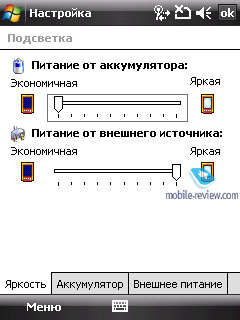
Back to the table of contents >>>
Camera
The communicator comes installed with a 3 Mpix camera (CMOS) with auto-focus, which is the same module as that found in the HTC TyTN II. That’s why it doesn’t take a rocket scientist to figure out these two cameras are totally identical in terms of image quality. To cut a long story short, the HTC Touch Cruise, as far as its camera options, settings and general image quality are concerned, is one of the best Windows Mobile powered communicators around.
The camera interface is similar to those found in the HTC TyTN II and the Touch Dual, down to the viewfinder mode, where you can access a stand-alone menu to make quick alterations to the camera’s essential settings. It is called up with one tap and removed from the display in a similar fashion. All settings are housed in a semi-transparent menu that pops up on the viewfinder’s screen.


The Cruise’s display also rooms all required thumbnails indicating what shooting modes have been activated. The top tow (from left to right) includes: current mode (still image, video, MMS video, sport, panorama, and portrait, multishot) and the number of shots left. All other options are available from the panel at the base of the screen that can be brought up by tapping it:
- Current image resolution
- White balance
- Exposure settings
- Storage place (internal memory, memory card)
- Currently active camera (main on the rear or the one on the front plate).
- Self-time
Looking to the left you will find the zoom bar, so to zoom in all you need to do is press one of the navigation pad’s directional keys (up or down) or just pick the zoom icon. Below is a rundown on how the Cruise’s zoom works:
| Image resolution |
Zoom |
| 3 M (2048x1536) |
Disabled |
| 2 M (1600x1200) |
Disabled |
| 1 M (1280x960) |
1x – 2x |
| 640x480 |
1x – 2x |
| 320x240 |
1x – 4x |
| 160x120 |
1x – 8x |
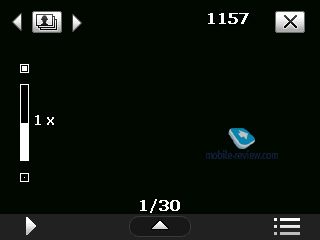
While capturing video, you can utilize only 2x zoom. Read on to find more about the Cruise’s video recording capabilities.
Still images
In this section we will be disclosing the camera settings for still images. The following image resolutions are available:
- 3 M – 2048x1536
- 2 M – 1600x1200
- 1 M – 1280x960
- L – 640x480
- M – 320x240
- S – 160x120
Image quality (for the most part affects image size):
- Super Fine
- Fine
- Normal
- Basic

White balance:
- Auto
- Daylight
- Night
- Incandescent
- Fluorescent
Overlays:
- Grayscale
- Sepia
- Cool
- Negative

Exposure:
The Cruise’s image quality can be adjusted with the help of one of the following settings as well: Contrast, Saturation, Sharpness (all on a 5-point scale). Additionally, you can setup the shutter sound, enable or disable the grid mode, timer, and time stamp.
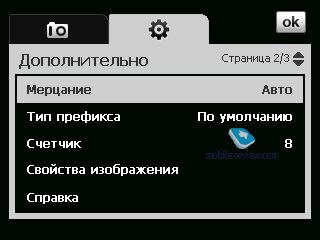
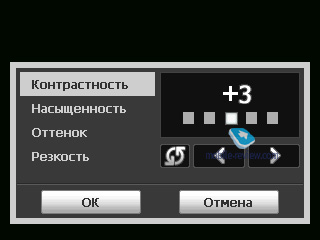

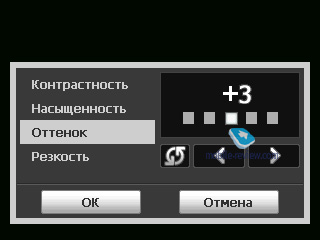
 |
 |
| (+) maximize, 2048x1536, JPEG |
(+) maximize, 2048x1536, JPEG |
 |
 |
| (+) maximize, 2048x1536, JPEG |
(+) maximize, 2048x1536, JPEG |
 |
 |
| (+) maximize, 2048x1536, JPEG |
(+) maximize, 2048x1536, JPEG |
 |
 |
| (+) maximize, 2048x1536, JPEG |
(+) maximize, 2048x1536, JPEG |
 |
 |
| (+) maximize, 2048x1536, JPEG |
(+) maximize, 2048x1536, JPEG |
 |
 |
| (+) maximize, 2048x1536, JPEG |
(+) maximize, 2048x1536, JPEG |
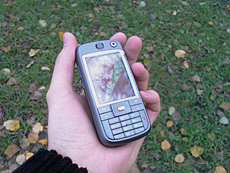 |
 |
| (+) maximize, 2048x1536, JPEG |
(+) maximize, 2048x1536, JPEG |
 |
 |
| (+) maximize, 2048x1536, JPEG |
(+) maximize, 2048x1536, JPEG |
 |
 |
| (+) maximize, 2048x1536, JPEG |
(+) maximize, 2048x1536, JPEG |
 |
 |
| (+) maximize, 2048x1536, JPEG |
(+) maximize, 2048x1536, JPEG |
 |
 |
| (+) maximize, 2048x1536, JPEG |
(+) maximize, 2048x1536, JPEG |
 |
 |
| (+) maximize, 2048x1536, JPEG |
(+) maximize, 2048x1536, JPEG |
 |
 |
| (+) maximize, 2048x1536, JPEG |
(+) maximize, 2048x1536, JPEG |
 |
 |
| (+) maximize, 2048x1536, JPEG |
(+) maximize, 2048x1536, JPEG |
 |
 |
| (+) maximize, 2048x1536, JPEG |
(+) maximize, 2048x1536, JPEG |
As long as you are in decent light conditions, the Cruise will keep snapping pretty good shots – very rarely does its color reproduction fall flat, and it almost never adds too much of green or blue to its images. So basically, the quality you get is pretty much in line with that of the HTC TyTN II.
 |
 |
| (+) maximize, 2048x1536, JPEG |
(+) maximize, 2048x1536, JPEG |
 |
 |
| (+) maximize, 2048x1536, JPEG |
(+) maximize, 2048x1536, JPEG |
 |
 |
| (+) maximize, 2048x1536, JPEG |
(+) maximize, 2048x1536, JPEG |
 |
 |
| (+) maximize, 2048x1536, JPEG |
(+) maximize, 2048x1536, JPEG |
When we were playing around with the Touch Cruise’s macro mode, it wasn’t a rare occasion when our unit just failed to focus on objects – find some examples above. However, this seems to be more like an issue with our particular communicator or its flawed software, and our primary reason to believe so are all those decent macro shots posted below.
Video
The Cruise records video in MP4 (codecs: mp4v or h.263) at 30 frames per second. Sound is recorded with the sAMR codec at 128 kbps (sample rate – 8000 Hz, mono).
The following video resolutions are available with the communicator:
- CIF – 352x288
- High– 320x240
- Normal – 176x144
- Small – 128x96
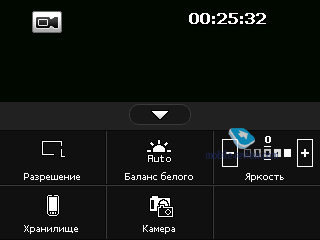

The settings adjustable in the camcoder mode are no different from those for still images, useful extras here include: sound recording (on/off), clip duration/size limits.
Like we already said, you can always go for 2x zoom in any of the available resolutions, even in CIF. The only letdown here is that you will never be able to zoom in or out while actually recording a video clip, so you will have to stop it, readjust and then start a new clip. The video quality you get with the Touch Cruise is pretty nice.
Generally, there are no size or duration limits for video files to be observed. However you can always opt for shorter clips so as to send them in multimedia messages (MSS mode).
Apart from the abovementioned Still image and Video modes, there are some more available with the Cruise:
- MMS video (shrunk resolution, size and duration)
- Caller ID
- Sport mode (a series of 3 to 10 snaps)
- Collage (framed picture)
- Panorama (the device automatically stitches 3 images into one)
- Multishot (a series of up to 30 snaps taken in rapid succession)
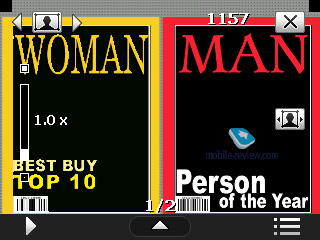
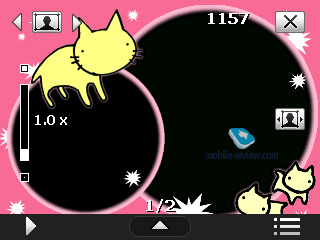



The time that passes from the moment you launch the camera application till the moment when you can enjoy a shot on its display averages 12 seconds. It takes the Cruise around 3-5 seconds to focus the camera, and for the macro mode the auto focus time rockets up to 8-9 seconds.
Back to the table of contents >>>
Battery life
The Touch Cruise utilizes a 1350 mAh Li-Ion battery, which is the most commonly used unit among today’s communicators.
The Cruise has a rated battery life of 400 hours of standby and up to 7 hours of talk time.
We will give this device’s cell a good run-through as soon as it starts shipping.
Back to the table of contents >>>
Performance
The HTC Touch Cruise is powered by the Qualcomm MSM 7200, just like the HTC TyTN II and the Touch Dual. Learn more about this platform in our thorough review of the HTC TyTN II.
The Touch Cruise’s CPU runs at 400 MHz. The communicator ships with 128 Mb of RAM, out of which around 100 Mb is available for applications and OS needs, though the system files occupy around 40 Mb of this volume, so you are down to roughly 60 Mb – this should be enough to allow for ten and more applications to run simultaneously on the Touch Cruise. The storage space that the user can manage makes 125 Mb, so you should experience no shortage in this department when it comes to installation of the most helpful and essential applications. And the rest can be thrown onto the memory card.
We have put the Cruise though its paces with the help of the benchmarks built into Core Player. Rates of 100% indicate that videos in the given resolution will be played back without any discernable slow-downs, frames might drop out only during dynamic scenes. And all performance rates better than 120-130% mean that the communicator’s computing power will be enough for perfect playback (no freezes or dropped frames) of videos in the given resolution and quality.
That’s how the Touch Cruise fares compared to the HTC TyTN II and the Glofiish X600

As the diagram tells us, the Touch Cruise is second to the E-Ten’s model in terms of video performance, and slightly ahead of the TyTN II. Naturally the Cruise trumps its predecessor, the HTC P3300 in this department hands down. Just like its major rivals, this communicator can playback converted video clips with no freezes or slow-downs, but that’s about it. Basically, the chipset’s video rendering abilities are not employed by applications.
The model is quite speedy when it comes to menu navigation. Generally speaking, you will feel right at home, in case you have some previous experience of using a contemporary communicator. And in standard applications (calls, text messages, mail checks) you won’t notice that marginal difference between the Touch Cruise and the models running on other 400 MHz CPUs.
Back to the table of contents >>>
Connectivity
The handset seamlessly taps into GSM (850/900/1800/1900) and UMTS (850, 1900, 2100) networks. Both EDGE and HSDPA high speed data protocols are supported by the Touch Cruise. Its wireless connectivity options include Wi-Fi and Bluetooth. For PC synchronization and data transfer purposes you can use the miniUSB cable shipping with the handset, apart from its Bluetooth wireless connectivity. The Cruise employs USB 2.0 standard, whose speed, in theory, tops out at 480 Mbit/s, however in real life we copied a 10 Mb file onto the Cruise over USB in 9-10 seconds.
For managing all wireless interfaces, the Touch Cruise utilizes an application from HTC’s suite of apps – Comm Manager.
The communicator also comes with Bluetooth 2.0+EDR module and already-standard Microsoft’s drivers. Below is a rundown on the profiles available with the Touch Cruise and their purposes:
- Generic Access Profile (GAP). Provides the basis for all other profiles.
- Serial Port Profile (SPP). Emulates COM-connection of devices. Used mainly for synchronization with desktop PC, coupling external Bluetooth-gadgets, like Bluetooth GPS-receiver.
- Object Push Profile (OPP). A basic profile for sending "objects" such as pictures, virtual business cards, or appointment details.
- Hands-Free Profile (HFP). Connection of Bluetooth-headset and handsfree device.
- Headset Profile (HSP). The most commonly used profile, providing support for the popular Bluetooth Headsets to be used with mobile phones.
- Human Interface Device Profile (HID). Connection of Bluetooth-keyboard.
- Advanced Audio Distribution Profile (A2DP). Sound transfer via Bluetooth.
- Audio Video Remote Control Profile (AVRCP). Music playback management via wireless headset.
- Personal Area Network Profile (PAN). Network connection via Bluetooth, use for connection of a desktop PC to Internet through the communicator, replaces Dual-Up Networking profile..
- SIM Access Profile (SAP). Allows connecting to a SIM card in a phone with Bluetooth, so the car phone itself doesn't require a separate SIM card.
- File Transfer Profile (FPT)/ File Transfer Profile (FTP). Provides access to the file system on another device. This includes support for getting folder listings, changing to different folders, getting files, putting files and deleting files.
Handling a stereo-headset was very easy with the Touch Cruise – we had no problems pairing it with the device, nor did we experience any delays in sound or improper operation of controls. The sonic experience delivered by the communicator is pretty much fine, but if you are into music, wireless earphones may not be the best way to go.
The Bluetooth settings now sport one interesting option that was previously unavailable with other models. Specifically, now you can set the time span during which the Touch Cruise will be detectable for other devices. And after that, other phones around won’t be able to track our Cruise, even though its Bluetooth module will still be online.

Wi-Fi 802.11b/g. The Cruise Wi-Fi module is a solid performer – we tested it with a Skype call made over Wi-Fi (your contact’s voice comes out of the loudspeaker).
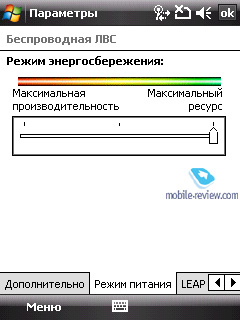
Back to the table of contents >>>
Software
The communicator runs on Windows Mobile 6 Professional. To learn more about the standard feature pack shipping with this operating system, go to our dedicated review.
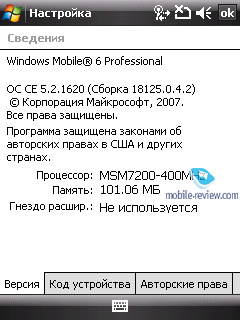
The HTC Touch Cruise and the HTC Touch Dual represent a leap up in the development of bundled software for HTC. These two models employ an extended version of the modules originally installed on the HTC Touch, which automatically brings new abilities for the Contact list alongside new applications.

Contact list
From this moment on, the Contact list always features the alphabet running down the right edge of the display, with its language being directly linked with your firmware default language.

Moving your finger down the list, you highlight every letter and once you hover over one for a moment, you will see this letter, yet magnified, in the center of the display.
So this side-bar is a pretty much potent replacement for the standard search function, of course, if your contact list doesn’t include 300 or more entries, when picking required contacts with the alphabet in the side-bar gets way too troublesome. This interface, in truth, has been adopted from Apple’s mobile phone, and it is not a bad thing – you will never find a more fitting solution for the range of touch-phones.
Start menu
The Start menu can now be magnified, which makes for easier finger-based navigation. In this case, you will see that both menu item names and their icons have grown up a little. The default OS version (with no add-ons) can’t even dream of such an option.
Image gallery
For you image viewing needs, HTC has come up with a pretty unsophisticated application, and by this we mean its very intuitive and straightforward interface and of course its focus on finger-based navigation. It is pretty neat and definitely differs from all standard Windows Mobile applications out there.

But as far as functionality is concerned, this application is no revolution when thinking of the Apple iPhone’s authority on the market. Essentially, HTC has employed the most user-friendly parts of the iPhone’s interface in its latest and greatest models. For the Image gallery, these amenities include gesture-based navigation through your pictures and ability to zoom in and turn photos with your finger tips.

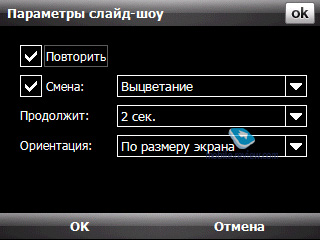

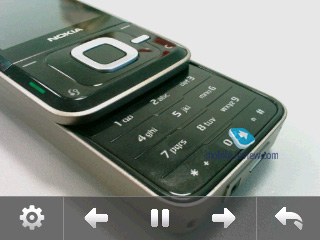
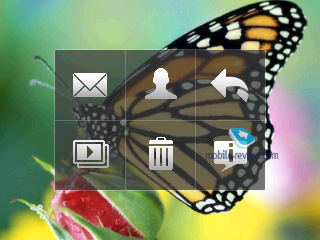
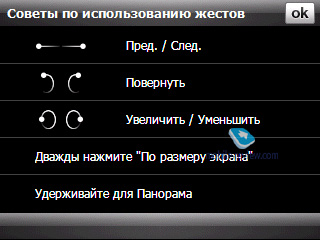

Video gallery
This application is also styled after the color scheme of all HTC’s new offerings – all black, almost no flamboyant elements or icons. In terms of functionality, it still offers nothing beyond viewing info on all video clips stored on your device and listing through thumbnails of all video files available – once you pick a clip and hit the Play button, the default media player kicks in immediately.

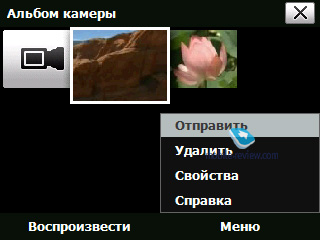
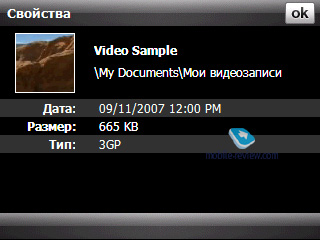
Input methods
HTC’s new models come armed with several new input methods, among which are on-screen keyboards (12- and 20-button ones), and a full-featured QWERTY pad. The latter is of more interest since it is pretty much suitable for stylus-less texting. However the strange thing is that for the HTC Touch Dual and HTC Touch Cruise it is available only in the menu, and there is no way you can call it up to type something elsewhere. That’s why we will wait for commercial units to come to share our impressions on it with you.
Java – emulator for applications written on Java. Its capabilities are very limited; in light of this fact 3D Java is not supported. In most cases support for Java-powered applications is not called-for on smartphones and communicators, since these days there are tons of applications for Windows Mobile out there. Some users make an exception for OperaMini as this app is simply the winner in the save-my-traffic contest. Another example - for Java-games addicts who need such an emulator badly. However the default emulator does not support additional libraries used for creation of Java applications for Nokia-, Motorola-branded and some other handsets. Hence nobody guarantees these applications will launch and operate properly.
Zip – HTC’s very own utility for handling archived files – you can extract data from an archive, or add new to an already existing compressed file.

Audio Manager – application similar to the standard Media Player. In terms of the abilities this app doesn’t differ from the built in player, saving for the interface.
However HTC’s own application packs tools for basic track editing, like cutting fragments so as to set them as ring tones afterwards. Now this operation can be performed hands down, even a newcomer won’t have any problems with doing that – you pick a track, specify the fragment you need (in seconds or on the progress bar). For example, you can select a 6-minute long song and take 30 seconds out of it by cutting off 2 minutes from the beginning and 3,5 minutes before the end.
Adobe Reader LE – is the most widely adopted application for viewing PDF documents, and this is its mobile edition. Much like its elder brother, the applications never seems to be in a hurry. Loading a page takes about 10-15 seconds, should the document contain a considerable number of schemes and pictures each page will load for half a minute or even longer. It should be noted that as far as small files are concerned, the viewing capabilities this application provides, are more than sufficient.
Streaming Media – used for playing streaming video and audio. In the Address field you specify a source and then the communicator starts uploading and playing back the content. In settings you will also be able to adjust Internet connection speed and buffer size.
Voice recorder – the most basic application for recording voice clips; doubles as a player for playing back the recordings you made, all sound clips can be set as call alerts.

Voice dial – self-explanatory application requires voice training, in other words, voice tags for specific contacts. However it does a pretty decent job, so having dealt with its settings once, you will never have to resetup it ever again.
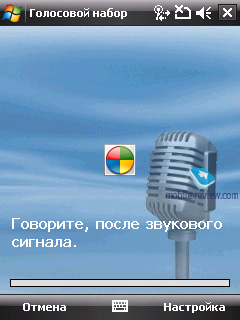
Task manager – with this utility Windows Mobile’s cross-shaped button can now actually terminate applications, rather than minimize them. Also, this program enables you to browse the list of currently running applications and memory volume that each of them takes up. While at the Today screen you will always find it in the top right corner – by tapping the icon you open a pop-up menu, which can close one or all applications at once.
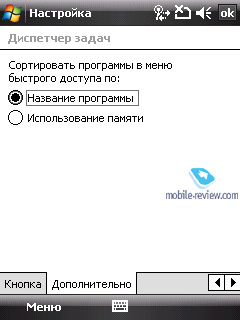
The HTC Touch Cruise sports bigger icons and fonts for this application. Also, now you can magnify the status bar containing current signal strength, battery status and other service indicators for better readability.
HTC Home – HTC's own skin for the Today screen is grabbing more features and getting more functionally rich overall. Whereas in the HTC Touch it had only three tabs, the HTC Touch Cruise boasts four of them: shortcuts to 9 applications, weather and time have been carried over from the HTC Touch. All these tabs are still housed in a horizontal bar and can be tapped with stylus or fingers.
TouchFLO
This technology, debuted with the HTC Touch, has been carried over to the new communicator along with HTC Home. All constituents and features of the TouchFLO technology, including the cube, are enabled in the HTC Touch Crusie (scrolling in lists, phonebook etc).
Moving on to the cube’s sides.
The main part of the interface is brought up by swiping your finger upwards from the bottom of the display, meaning that you should simply slide from any point at the screen’s base upwards. Having done that, you will see the face of the cube you used last time. Switching between the sides is done via horizontal swipes. Similarly to when you are calling the cube up, these gestures can be done in any part of the display. To shut the interface down you need to perform a move opposite to the one you launched it with, in other words, slide your finger downwards.
The first face – shortcuts to applications, including e-mail, SMS/MMS, Internet Explorer, Tasks, Comm Manager, Calendar. It is important to realize that starting up these programs from the revamped interface won’t change their actual looks, meaning that launching the Calendar app will bring nothing but a standard Windows Mobile 6 application. The same holds true for the rest of the applications. The new interface is kind of a tool that makes for faster and more intuitive access to these programs. You can’t change the pool of shortcuts available from this face of the cube. Although, we really want to hope that next interface versions will offer this ability. I suppose you will agree that having frequently used applications, like favorite browser, ICQ-client or music player in one place is much handier.
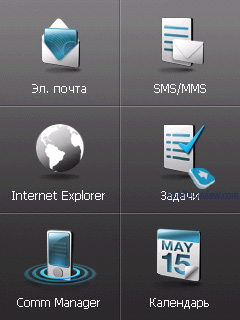
The next side – access to multimedia applications, from this menu you normally start up “Audio-manager”, “Image gallery” and “Video Gallery”. All these applications have been designedby HTC.
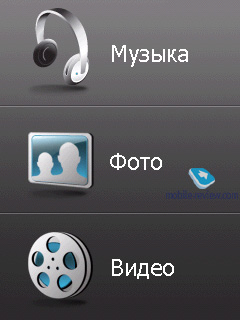
Audio-manager has already made several appearances in our previous reviews – it is a music player totally identical to the stock Windows Media Player in terms of what it does. If you start music playback and bring up the cube again, once you turn it to the Audio manager tab, you will see info on currently playing track music buttons right on it.
The last side available through the cube contains 9 contacts, displayed as thumbnails of images you can bind up with any entry in the phonebook. There is only one thing to keep in mind when dealing with this side – you can throw here only contacts stored in the device’s memory, meaning that no entries found on the SIM-card are allowed.

Deleting contacts from this panel couldn’t be easier – you need to push the dedicated button at the base of the display and then touch the thumbnails you no longer want to see here. Upon tapping a thumbnail you jump into this contact’s menu, where you decide what to do – dial it, send mail or text message, etc.

If you throw an entry without an image attached onto this list, you will see its bare name on the background of someone bald and grey. From the contact panel you can also get to the phonebook and call log. The latter, just like a couple of other applications, is enhanced with TouchFLO, so that you can page through the list of calls by swiping upwards/downwards.
The dialing display is also style-keyed to the HTC’s design. Apart from that all buttons have captions in Russian, which is not something you will find on the default OS version’s spec sheet.
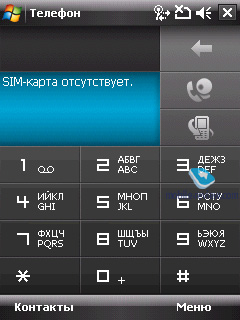
Opera
Our unit came preinstalled with Opera for Mobile browser. We can’t say for sure whether this application will stay on board for commercial units, but there is a good chance it will.
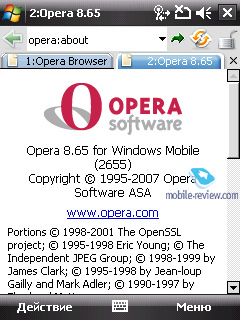
Back to the table of contents >>>
GPS
Like all other components of the communicator, its navigation department builds upon the Qualcomm’s platform. The Touch Cruise’s navigator employs the gpsOne technology – in a word, this is a Qualcomm’s development, comprising a couple of tracking systems. In sum, there are four methods under its belt – satellites and three data processing systems (via your carrier’s network) The simplest of them serves for adjusting the satellite’s data, the second stands for data update and the third – full fledged data reception via the carrier’s network. MS (mobile station)-Based, MS-Assisted and MS-Assisted/Hybrid respectively.
However our focus here is the conventional navigation method – via satellites. To back up our words with some figures, we put the navigation front of the HTC Touch Cruise with its Qualcomm solution up against one of the market’s best navigation savvy solutions – the Mitac Mio A501 running on the SiRF Star III.
The Touch Cruise’s cold start time makes roughly a minute, after that, all next launches take less than 20 seconds.
Now on to the Touch Cruise’s positioning accuracy.

(+) maximize image
The tracks plotted by either of the communicators aren’t all that different, both have slight deviations from the course, nothing critical though.
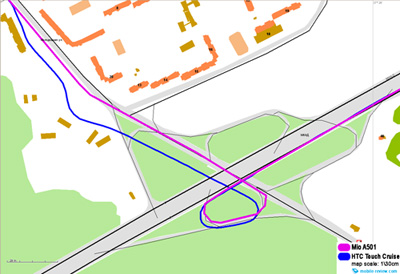
(+) maximize image
It is the only time the HTC Touch Cruise fell flat during our test (over 40 km).
As you can see from the images above, the positioning accuracy of the HTC Touch Cruise is on a par with solutions from Mio, E-Ten and Asus running on the Sirf Star III. The handset ships with a full version of TomTom navigation app, and on top of that one free card is available for download (any city in Europe or the US).
The OS comes preinstalled with an application for handling GPS – QickGPS, which allows updating satellites date via the Internet to speed the things up.
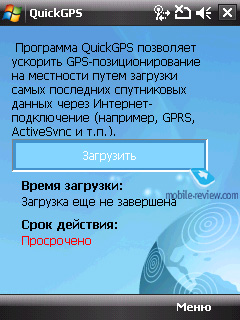
Back to the table of contents >>>
Sales package, sound
Our judgment on the Touch Cruise’s sound quality, RMAA tests, and a rundown of all accessories coming in one box with the communicator will be added later, when we get our mitts on a commercial unit.
The communicator ships with an FM-radio module. Nothing special about it, though. It can only start up when you have a headset or a pair of earphones plugged in.
Back to the table of contents >>>
Impressions
The Touch Cruise does well on the reception front. The communicator comes with polyphony, however since a multitude of audio formats may be employed for ring tones, having it onboard is not vital at all. The volume of call alerts is average, which still proves sufficient to make ring tones audible in typical environments. Also, during our calls, we had no complaints about how loud the other party sounded, even when we were on a busy street or in a bus.

When the communicator starts shipping in Russia, it will go for around 700-800 USD, which is steeper than most thumbboard-less Windows Mobile solutions out there. New Gigabyte- and E-Ten branded solutions very rarely break the watermark of 700 USD. So if you face it off against other offerings currently available on the market, the HTC Touch Cruise won’t be a clear winner, and it is not the most technologically talented communicator around either. But that’s where other factors come into play.
First off, remember the first months of the HTC P3300’s sales, pre-Christmas and post-Christmas seasons – it never had a really bad downswing, even with its not exactly adequate price tag when it only debuted, and even these days. And in spite of that, people have been falling for it, actually a lot of people, generating some truly stellar sales for the market of Windows Mobile. What is the reason? In many respects, it was a run-of-the-mill solution, and HTC wasn’t trying to make a “do-it-all” solution or a mobile powerhouse of the P3300. Back when the company rolled out the P3300, they had a clear-cut strategy in mind, and this communicator has shown that the path they picked is, if not optimal, by far not the worst out there.
For many the P3300 was a handset and a navigator above all other things, and only then – a communicator, which is not something we have used to see with devices running Windows Mobile. The fact is most owners of these devices do know that they are using a Windows Mobile based solution. This paradigm got cracked with the P3300, and by establishing its Touch series, HTC is set to disrupt it for good. And that’s the standpoint you should apply when judging the Touch Cruise.
The HTC Touch Cruise is a style-conscious phone with touch-sensitive controls and some navigation-related smarts in the first place. Most of its users or let’s say potential users, won’t be pondering over its price/quality ratio, CPU speed or display resolution. Even though all these aspects are pretty decent here, especially keeping in mind that the QVGA resolution is available only with top-of-the-line models on the phone market.
The HTC P3300’s successor has turned out to be a pretty offering, despite its questionable design and a hefty price tag. The company is following the path it picked long ago, and makes everything possible to move towards the mass market with care and persistence.
The HTC Touch Cruise combines the abilities of Qualcomm’s new platform – pretty decent speed in menu and applications for navigation, potent camera and a tidy menu interface that can be managed with your fingers alone. As for its price, the Cruise is pretty much overrated, but will this mar its sales? Probably not.
Specifications:
- Type: communicator
- Form-factor: side-slider with screen tilting mechanism
- Position in the range: above HTC P3300
- Rivals: Glofiish X600, Mio A501
- Materials used: plastic, soft-touch finish
- Operating system: Windows Mobile 6 Professional
- CPU: 400 Mhz based on the Qualcomm MSM7200
- RAM: 128 Mb (100 Mb available to the user)
- ROM: 256 Mb, 125 Mb available to the user
- Connectivity: microSDHC (SDIO, any size), Bluetooth 2.0+EDR (A2DP), USB 2.0 for synchronization/charging, Wi-Fi (IEEE802.11b/g), proprietary headset socket, external GPS antenna slot
- Display: TFT 2.8” (active area - 43.2x57.6 mm), 240x320-pixel resolution , 65 K colors, adjustable backlighting brightness (1 to 10 scale)
- Extras: bundled Qualcomm (gpsOne) based GPS, FM-radio
- Battery: detachable 1350 mAh Li-Ion (pol) unit
- Dimensions: 110x58x15.5 mm
- Weight: 130 g (battery included)
Back to the table of contents >>>
Artem Lutfullin (artem.lutfullin@mobile-review.com)
Translated by Oleg Kononosov (oleg.kononosov@mobile-review.com)
Published — 15 November 2007
Have something to add?! Write us... eldar@mobile-review.com
|
News:
[ 31-07 16:21 ]Sir Jony Ive: Apple Isn't In It For The Money
[ 31-07 13:34 ]Video: Nokia Designer Interviews
[ 31-07 13:10 ]RIM To Layoff 3,000 More Employees
[ 30-07 20:59 ]Video: iPhone 5 Housing Shown Off
[ 30-07 19:12 ]Android Fortunes Decline In U.S.
[ 25-07 16:18 ]Why Apple Is Suing Samsung?
[ 25-07 15:53 ]A Few Choice Quotes About Apple ... By Samsung
[ 23-07 20:25 ]Russian iOS Hacker Calls It A Day
[ 23-07 17:40 ]Video: It's Still Not Out, But Galaxy Note 10.1 Gets An Ad
[ 19-07 19:10 ]Another Loss For Nokia: $1 Billion Down In Q2
[ 19-07 17:22 ]British Judge Orders Apple To Run Ads Saying Samsung Did Not Copy Them
[ 19-07 16:57 ]iPhone 5 To Feature Nano-SIM Cards
[ 18-07 14:20 ]What The iPad Could Have Looked Like ...
[ 18-07 13:25 ]App Store Hack Is Still Going Strong Despite Apple's Best Efforts
[ 13-07 12:34 ]Infographic: The (Hypothetical) Sale Of RIM
[ 13-07 11:10 ]Video: iPhone Hacker Makes In-App Purchases Free
[ 12-07 19:50 ]iPhone 5 Images Leak Again
[ 12-07 17:51 ]Android Takes 50%+ Of U.S. And Europe
[ 11-07 16:02 ]Apple Involved In 60% Of Patent Suits
[ 11-07 13:14 ]Video: Kindle Fire Gets A Jelly Bean
Subscribe
|
